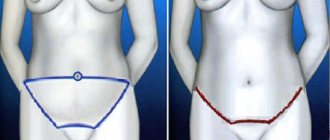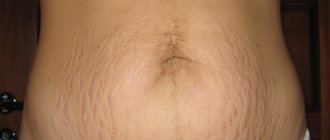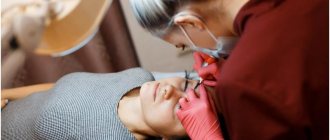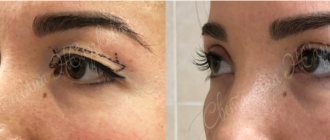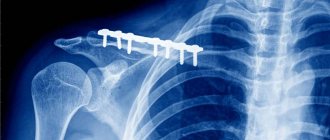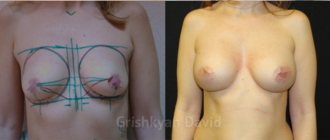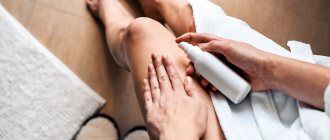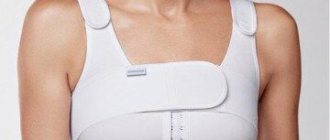Recovery and care of sutures after cesarean section
Women who have undergone this operation should prepare themselves, first of all mentally, for the presence of pain in the incision area for 15-20 days.
At first, it is advisable to take anesthetics to reduce pain. For two to three weeks after the intervention, when walking, you must use a special postoperative bandage or tie up your stomach with a diaper or towel. After a caesarean section there is no need to lie in bed for a long time; on the contrary, it is better to gradually get into the rhythm of life, but with a gentle regime. Getting up early and carefully engaging in daily activities - caring for a newborn, light walks stimulate uterine contractions, accelerate the regeneration of damaged tissue, promote faster healing of the postoperative incision and help intestinal motility. Throughout the entire period the patient is in the maternity hospital, the procedural nurse changes the postoperative dressing every day and lubricates the sutures with disinfectants (antiseptics). The area in which the intervention took place must be protected from water - when performing hygienic water procedures in the intimate area, the bandage should be covered with a towel or waterproof material. It is also important that clothes that, to one degree or another, may come into contact with the scar, are always clean, first of all, this applies to underwear and nightgowns or pajamas - they should be changed at least once a day, more often if necessary.
When the sutures are removed, the patient can leave the walls of the medical facility and take a shower. In most cases, after removing the sutures, this area does not require any additional manipulations - neither medical nor at home. During the first two weeks of staying at home, the scar is prescribed to be washed twice a day with soap and water, and in no case to rub, but to carefully absorb the water until dry with a clean (just washed) or disposable towel.
During the healing period of damaged tissues, preference should be given to lightweight, highly breathable underwear; Rough and too dense materials can not only interfere with the regeneration process, but also aggravate the condition of already injured skin. As for your regular wardrobe, it is better to choose loose cotton trousers with a high waistline. In the first month after the birth of the child, the mother is recommended to use a special bandage, but even under this condition, the woman must avoid lifting objects that weigh more than the weight of the baby itself. At first, the incision site may itch quite noticeably - this indicates an ongoing regeneration process, but you cannot give in to temptation, you need to endure this period. After two weeks after the operation, the scar can begin to be treated with products (ointments and creams) that help restore the skin.
Types of episiotomy
Episiotomy is performed during childbirth to prevent spontaneous tissue rupture, because the direction of the laceration will be uncontrollable. Prolapse of the pelvic organs may occur and severe bleeding may occur.
In medical practice, one of two types of gynecological operations is used during childbirth :
- The standard type of incision (anatomical) involves the doctor mentally drawing a line that starts at the seat and ending at the back of the vagina and makes an incision. Internal organs, nerve fibers, and large muscles are not damaged. Bleeding may start but can be easily stopped. This type of operation has one feature: if the incision is small, it can be extended.
- The second type - perineotomy - differs from the first in the direction of the incision - from the vagina to the anus. There are several types of perineotomy: mid-lateral, purely lateral episiotomy. Indications for the procedure are the special anatomical build of the woman: high or, conversely, low crotch. The height of the perineum is determined before birth. Pregnant women with such characteristics should be prepared for a difficult birth. This type of surgery is risky because the Bartholin's gland can be damaged.
Lifestyle with sutures on the cervix, vagina and perineum
Cervical ruptures during labor and subsequent suturing of the ruptures do not impose additional restrictions on a woman’s activity, unlike perineal injuries.
If there are tears and seams in the perineal area, the young mother is instructed to strictly follow the following recommendations:
- During the first three weeks after childbirth, sitting positions should be avoided; this period is necessary for the complete fusion of the muscles of the perineum and pelvic floor. It is necessary to perform all usual activities (eating, performing hygiene procedures, personal care), as well as taking care of the newborn while standing or lying down. This also applies to traveling in a car - the back seat must be cleared so that a woman can sit there comfortably and safely. There are special positions to avoid stress on the perineum, “half-sided”, “leg to leg”, the doctor should explain this in detail. An excellent option for active mothers is an orthopedic circle; you can even sit on it while driving.
— Visit the toilet to have timely bowel movements and avoid constipation. The patient is allowed to sit on the toilet on the first day after birth. To facilitate the process of defecation, mother can use suppositories (rectal suppositories) with glycerin and other herbal remedies. These effective and at the same time safe drugs help intestinal function and smooth bowel movements. If necessary, the doctor may prescribe other medications, but it must be remembered that when breastfeeding, the baby also receives these substances.
- Do not lift heavy objects. It is highly not recommended to deal with objects and things weighing more than three kilograms, so if the child is large (4 kg or more), you should ask for help from family and friends until the mother’s condition is completely normalized.
How long does it take for stitches to dissolve after childbirth?
As a rule, sutures are removed independently on the 4th day after application. Further treatment involves the use of healing suppositories and hygienic compositions.
The advantages of these manipulations are:
- no discomfort;
- fast recovery;
- absence of scars after complete healing.
Rules for caring for postpartum sutures on the perineum
While the woman is in the maternity hospital, the sites of ruptures or incisions are treated by a procedural nurse - care consists of washing the sutures with hydrogen peroxide and then applying brilliant green or iodine to them.
Patients with stitches on the external genitalia upon discharge from a medical institution are required to receive recommendations on how to care for the intimate area.
Postpartum instructions include the following important points:
— Choose underwear of the appropriate size to wear. Panties that are too small or insufficiently wide can put pressure on injured areas and prevent stitches from healing. The material from which the underwear is made is also important; give preference to natural materials, preferably cotton - synthetic fabrics often cause skin irritation and various types of inflammation.
— Observe the rules of intimate hygiene: during this period, it is necessary to wash the external genitalia twice a day with simple soap without aggressive components and synthetic fragrances (scented gels should be avoided, but baby soap is ideal), and additionally wash your face every two hours and change your panty liner ; in addition, it is required to treat the genitals with warm water after each visit to the toilet. It is important to wash the seam on the crotch not only carefully, but also thoroughly; you can direct the shower stream at it.
- Douching is strictly prohibited!
— After hygienic manipulations, carefully blot your genitals with a towel; friction can damage already vulnerable tissues.
- Provide air flow to the genitals from time to time - periodically it is recommended to lie on a bed or sofa, take off your panties, spread your legs apart and bend them at the knees.
— Empty your bladder in a timely manner, otherwise the filled organ will put pressure on the uterus and prevent its contraction.
How are the seams treated?
To do this, use hydrogen peroxide, alcohol and antiseptic solution. They block the growth of pathogenic microflora inside the wound and stimulate rapid regeneration of the skin.
Healing time for external sutures on the perineum
It's no secret that all mothers who have just given birth are interested in the question of how long postpartum sutures last. The healing process is directly related to the size of the wound surface, the correctness of care during the recovery period, the general condition of the woman’s body, and the techniques and materials used when suturing. If self-absorbable threads (natural or synthetic) were used during suturing, healing will take about two weeks, and scar formation when using metal staples or non-absorbable threads takes longer - 15-30 days; in the latter case, the sutures are removed in the maternity hospital before discharge, approximately on the seventh day after birth.
Who should have an episiotomy?
An episiotomy performed during childbirth is a forced measure carried out in the name of saving the baby or causing trouble for the woman in labor. The dissection procedure is performed only if there is a threat to the life of the child or the woman in labor.
From medical journals it is known that 50 out of 100 women in labor undergo an episiotomy.
There is no predisposition to an episiotomy, but the reasons for the operation may be the following:
- premature birth, which may result in damage to the fetal head;
- the child cannot come out: he is large or has a large head;
- the woman in labor has high blood pressure and the labor process is slow;
- it is necessary to apply medical forceps to increase the entrance to the vagina;
- childbirth occurs with abnormalities;
- the child is suffering (he has a breech position, lack of oxygen); the rapid progress of labor will help him to be born healthy;
- malposition;
- The pregnant woman has complex diseases of the heart, nervous system, and inelastic tissue.
Features of caring for internal sutures (in the vagina and cervix)
Sutures on the internal genital organs made with absorbable threads (such suture material is called catgut, in modern institutions, vicryl or safil) do not require complex manipulations. They do not need to be removed or washed with any solutions; it is enough for the young mother to ensure complete rest and strictly adhere to the rules of personal intimate hygiene so that the infection does not enter the organs of the reproductive system, since discharge in the postpartum period (especially the first twenty days) is a favorable environment for reproduction pathogenic microbes.
Perform any intimate procedures after washing your hands first - this applies to washing your genitals, visiting the toilet, changing sanitary pads, etc. After each visit to the toilet, remove the used pad and wash yourself, so that the direction of movement goes from the vulva to the rectum with warm water and soap.
Remember - the intestinal microflora should under no circumstances get on the genitals, which is why it is so important to follow this sequence of actions. After treating the perineum with water, gently pat it dry with a clean or disposable towel, collecting all the moisture. If you use linen products, change them at least once a day, and more often as they become dirty. Empty your bladder every three to four hours, even if you don't feel the urge to urinate. You will have to avoid taking a bath in the first month after giving birth.
What is an episiotomy?
Episiotomy is a minor obstetric operation performed at the moment when the child is already close to the exit, but cannot exit for a number of reasons. The doctor prepares for the operation while the woman in labor is resting from contractions. One blade of the scissors is carefully inserted into the perineum at an angle of 45 degrees. It is necessary that it touches the skin, which is already stretched from efforts and resembles parchment paper.
Once labor resumes, the doctor makes an incision. The woman in labor does not feel pain, her attention is focused on childbirth, so surgery is done without general anesthesia.
An injection of lidocaine or novocaine is given, but sometimes the situation becomes critical and there is not enough time to give the injection. The cut is made instantly. After the baby is born, the perineum is sutured with surgical threads.
1) Yellow peeling
Yellow peeling is one of the most popular methods that restores the beauty and appearance of the skin by removing dead skin particles.
Removing stretch marks and scars using peeling is quite simple. The skin is first cleansed of cosmetics. A mass of salicylic and glycolic acid is applied to the cleansed part of the body. The substances in the mixture help eliminate dead cells. After a few minutes the mixture is washed off. Next, the skin area is covered with retinoic acid. Depending on the density of the mixture, it is either washed off after 20-30 minutes or remains longer. After removing the mixture, the skin is lubricated with a cream that a specialist will prescribe for you. You will also be prescribed to take anti-inflammatory drugs to avoid itching or skin rashes.
Effective for stretch marks and stretch marks after pregnancy, post-acne scars. Yellow peeling also fights age-related changes and pigmentation.
The procedure for removing stretch marks and scars with yellow peeling is contraindicated:
- during pregnancy or planning it;
- nursing women;
- for viral infections, also for herpes and women who have had hepatitis;
- if you are allergic to the components of the drug.
Yellow peeling does not harm the skin and is also painless. During the first procedure you will see external changes. Peeling is carried out 1-2 times with an interval of several weeks.
How is an episiotomy performed?
Episiotomy during childbirth: what is it, the technique of making the incision is as follows:
- The intended incision line is treated with an antiseptic.
- If a woman in labor is afraid of surgery, she is given local anesthesia.
- The doctor inserts medical scissors into the woman's vagina and, after waiting for a wave of pushing, cuts the tissue. The maximum depth of incision is 5 cm, the minimum is 3 cm. The midwife who is nearby, preventing the child from leaving, holds his head with his hand.
The operation is performed in the second stage of labor, when the skin and muscle tissue of the perineum do not stretch and prevent the appearance of the baby's head.
Treatment of hemorrhoids
Treatment of hemorrhoids in nursing women should exclude all substances that can harm the baby. During pregnancy, the range of approved drugs is even narrower. Traditional medicine is also not completely safe. Even when the third or fourth stage is advanced, they try to delay surgical intervention as much as possible. Therefore, self-medication is extremely dangerous. A doctor should prescribe medications and monitor the situation. With drug treatment, the doctor prescribes suppositories, ointments, tablets that relieve inflammation, strengthen the walls of blood vessels and relieve pain. Sometimes, at the initial stage of hemorrhoids, a pregnant woman is not treated at all, but is only prescribed diets and mild laxatives.
Is there an alternative?
Episiotomy during childbirth does not exclude an alternative option. What is this: a new type of surgical intervention or adherence to the advice of a gynecologist?
The point is that a pregnant woman should consciously prepare for childbirth:
- A woman preparing to become a mother can attend a swimming pool or sports activities. You can practice at home. A set of exercises aimed at increasing the elasticity of the perineal tissue will help her avoid perineal rupture during childbirth.
- Intimate massage is effective, which consists of massaging the perineum and vagina, because it is this area that is stretched during childbirth. The procedure is learned at courses for pregnant women. You will need cosmetic oil based on medicinal herbal extracts. Before the massage, you should take a shower to relax your body and lubricate your fingers with oil. Circular movements inside the intimate area should be carried out until a feeling of tension in the skin tissue appears.
- The ability to control your own breathing is of no small importance, because it is in the minutes of exhalation that you can relax. This will help you get closer to the physiological course of the birth process and avoid all kinds of complications.
- A pregnant woman should lead a healthy lifestyle and eat right.
A woman must understand that it depends on her whether the child can be born healthy.
